Balbharti Maharashtra State Board 11th Physics Textbook Solutions
Chapter 4 Laws of Motion Textbook Exercise Questions and Answers.
1. Choose the correct answer.
Question 1.
Consider following pair of forces of equal magnitude and opposite directions:
(P) Gravitational forces exerted on each other by two point masses separated by a distance.
(Q) Couple of forces used to rotate a water tap.
(R) Gravitational force and normal force experienced by an object kept on a table.
For which of these pair/pairs the two forces do NOT cancel each other’s translational
effect?
(A) Only P
(B) Only P and Q
(C) Only R
(D) Only Q and R
Answer:
(A) Only P
Question 2.
Consider following forces: (w) Force due to tension along a string, (x) Normal force given by a surface, (y) Force due to air resistance and (z) Buoyant force or upthrust given by a fluid.
Which of these are electromagnetic forces?
(A) Only w, y and z
(B) Only w, x and y
(C) Only x, y and z
(D) All four.
Answer:
(D) All four.

Question 3.
At a given instant three point masses m, 2m and 3m are equidistant from each other. Consider only the gravitational forces between them. Select correct statement/s for this instance only:
(A) Mass m experiences maximum force.
(B) Mass 2m experiences maximum force.
(C) Mass 3m experiences maximum force.
(D) All masses experience force of same magnitude.
Answer:
(C) Mass 3m experiences maximum force.
Question 4.
The rough surface of a horizontal table offers a definite maximum opposing force to initiate the motion of a block along the table, which is proportional to the resultant normal force given by the table. Forces F1 and F2 act at the same angle θ with the horizontal and both are just initiating the sliding motion of the block along the table. Force F1 is a pulling force while the force F2 is a pushing force. F2 > F1, because
(A) Component of F2 adds up to weight to increase the normal reaction.
(B) Component of F1 adds up to weight to increase the normal reaction.
(C) Component of F2 adds up to the opposing force.
(D) Component of F1 adds up to the opposing force.
Answer:
(A) Component of F2 adds up to weight to increase the normal reaction.
Question 5.
A mass 2m moving with some speed is directly approaching another mass m moving with double speed. After some time, they collide with coefficient of restitution 0.5. Ratio of their respective speeds after collision is
(A) 2/3
(B) 3/2
(C) 2
(D) ½
Answer:
(B) 3/2
Question 6.
A uniform rod of mass 2m is held horizontal by two sturdy, practically inextensible vertical strings tied at its ends. A boy of mass 3m hangs himself at one third length of the rod. Ratio of the tension in the string close to the boy to that in the other string is
(A) 2
(B) 1.5
(C) 4/3
(D) 5/3
Answer:
(B) 1.5
Question 7.
Select WRONG statement about centre of mass:
(A) Centre of mass of a ‘C’ shaped uniform rod can never be a point on that rod.
(B) If the line of action of a force passes through the centre of mass, the moment of that force is zero.
(C) Centre of mass of our Earth is not at its geometrical centre.
(D) While balancing an object on a pivot, the line of action of the gravitational force of the earth passes through the centre of mass of the object.
Answer:
(D) While balancing an object on a pivot, the line of action of the gravitational force of the earth passes through the centre of mass of the object.
Question 8.
For which of the following objects will the centre of mass NOT be at their geometrical centre?
(I) An egg
(II) a cylindrical box full of rice
(III) a cubical box containing assorted sweets
(A) Only (I)
(B) Only (I) and (II)
(C) Only (III)
(D) All, (I), (II) and (III).
Answer:
(D) All, (I), (II) and (III).
2. Answer the following questions.
Question 1.
In the following table, every entry on the left column can match with any number of entries on the right side. Pick up all those and write respectively against A, B, C and D.
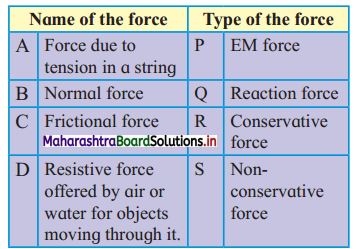
Answer:

Question 2.
In real life objects, never travel with uniform velocity, even on a horizontal surface, unless something is done? Why
is it so? What is to be done?
Answer:
Question 3.
For the study of any kind of motion, we never use Newton’s first law of motion directly. Why should it be studied?
Answer:
Question 4.
Are there any situations in which we cannot apply Newton’s laws of motion? Is there any alternative for it?
Answer:
Question 5.
You are inside a closed capsule from where you are not able to see anything about the outside world. Suddenly you feel that you are pushed towards your right. Can you explain the possible cause (s)? Is it a feeling or a reality? Give at least one more situation like this.
Answer:
Question 6.
Among the four fundamental forces, only one force governs your daily life almost entirely. Justify the statement by stating that force.
Answer:
Thus, out of the four fundamental forces, electromagnetic force governs our daily life almost entirely.
Question 7.
Find the odd man out:
(i) Force responsible for a string to become taut on stretching
(ii) Weight of an object
(iii) The force due to which we can hold an object in hand.
Answer:
Weight of an object.
Reason: Weight of an object (force due to gravity) is a non-contact force while force responsible for a string to become taut (tension force) and force due to which we can hold an object in hand (normal force) are contact forces.

Question 8.
You are sitting next to your friend on ground. Is there any gravitational force of attraction between you two? If so, why are you not coming together naturally? Is any force other than the gravitational force of the earth coming in picture?
Answer:
In Chapter 5, you will study about force of gravitation in detail.
Question 9.
Distinguish between:
(A) Real and pseudo forces,
(B) Conservative and non-conservative forces,
(C) Contact and non-contact forces,
(D) Inertial and non-inertial frames of reference.
Answer:
(A) Real and pseudo forces,
(B) Conservative and non-conservative forces,
(C) Contact and non-contact forces,
(D) Inertial and non-inertial frames of reference.
Question 10.
State the formula for calculating work done by a force. Are there any conditions or limitations in using it directly? If so, state those clearly. Is there any mathematical way out for it? Explain.
Answer:
Conditions/limitations for application of work formula:
Integral method to find work done by a variable force:
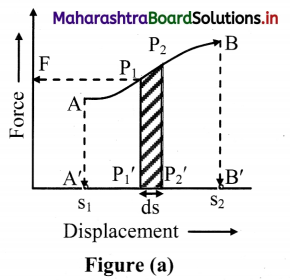
Question 11.
Justify the statement, “Work and energy are the two sides of a coin”.
Answer:
Thus, work and energy are the two sides of the same

Question 12.
From the terrace of a building of height H, you dropped a ball of mass m. It reached the ground with speed v. Is the relation mgH = \(\frac{1}{2} m \mathrm{v}^{2}\) applicable exactly? If not, how can you account for the difference? Will the ball bounce to the same height from where it was dropped?
Answer:
Question 13.
State the law of conservation of linear momentum. It is a consequence of which law? Given an example from our daily life for conservation of momentum. Does it hold good during burst of a cracker?
Answer:
Question 14.
Define coefficient of restitution and obtain its value for an elastic collision and a perfectly inelastic collision.
Answer:
i. For two colliding bodies, the negative of ratio of relative velocity of separation to relative velocity of approach is called the coefficient of restitution.
ii. Consider an head-on collision of two bodies of masses m1 and m2 with respective initial velocities u1 and u2. As the collision is head on, the colliding masses are along the same line before and after the collision. Relative velocity of approach is given as,
ua = u2 – u1
Let v1 and v2 be their respective velocities after the collision. The relative velocity of recede (or separation) is then vs = v2 – v1

iii. For a head on elastic collision, According to the principle of conservation of linear momentum,
Total initial momentum = Total final momentum
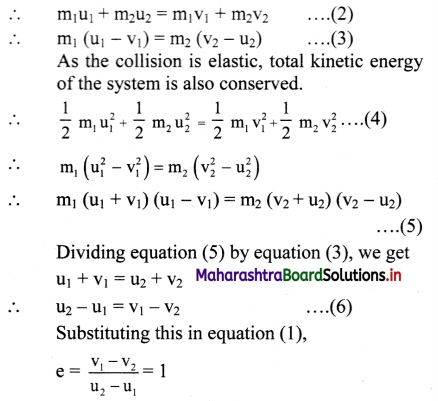
iv. For a perfectly inelastic collision, the colliding bodies move jointly after the collision, i.e., v1 = v2
∴ v1 – v2 = 0
Substituting this in equation (1), e = 0.

Question 15.
Discuss the following as special cases of elastic collisions and obtain their exact or approximate final velocities in terms
of their initial velocities.
(i) Colliding bodies are identical.
(ii) A very heavy object collides on a lighter object, initially at rest.
(iii) A very light object collides on a comparatively much massive object, initially at rest.
Answer:
The final velocities after a head-on elastic collision is given as,

i. Colliding bodies are identical
If m1 = m2, then v1 = u2 and v2 = u1
Thus, objects will exchange their velocities after head on elastic collision.
ii. A very heavy object collides with a lighter object, initially at rest.
Let m1 be the mass of the heavier body and m2 be the mass of the lighter body i.e., m1 >> m2; lighter particle is at rest i.e., u2 = 0 then,

i.e., the heavier colliding body is left unaffected and the lighter body which is struck, travels with double the speed of the massive striking body.
iii. A very light object collides on a comparatively much massive object, initially at rest.
If m1 is mass of a light body and m2 is mass of heavy body i.e., m1 << m2 and u2 = 0. Thus, m1 can be neglected.
Hence v1 ≅ -u1, and v2 ≅ 0.
i.e., the tiny (lighter) object rebounds with same speed while the massive object is unaffected.
Question 16.
A bullet of mass m1 travelling with a velocity u strikes a stationary wooden block of mass m2 and gets embedded into it. Determine the expression for loss in the kinetic energy of the system. Is this violating the principle of conservation of energy? If not, how can you account for this loss?
Answer:
Loss in the kinetic energy during a perfectly inelastic head on collision:
Question 17.
One of the effects of a force is to change the momentum. Define the quantity related to this and explain it for a variable
force. Usually when do we define it instead of using the force?
Answer:
Need to define impulse:
Impulse for a variable force:
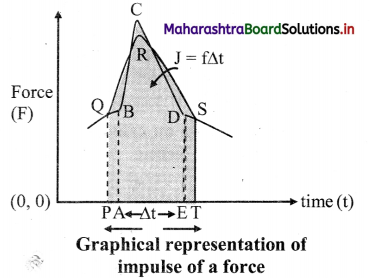
In chapter 3, you have studied the concept of using area under the curve.

Question 18.
While rotating an object or while opening a door or a water tap we apply a force or forces. Under which conditions is this process easy for us? Why? Define the vector quantity concerned. How does it differ for a single force and for two opposite forces with different lines of action?
Answer:
Question 19.
Why is the moment of a couple independent of the axis of rotation even if the axis is fixed?
Answer:
Question 20.
Explain balancing or mechanical equilibrium. Linear velocity of a rotating fan as a whole is generally zero. Is it in
mechanical equilibrium? Justify your answer.
Answer:
Question 21.
Why do we need to know the centre of mass of an object? For which objects, its position may differ from that of the centre of gravity?
Use g = 10 m s-2, unless, otherwise stated.
Answer:
3. Solve the following problems.
Question 1.
A truck of mass 5 ton is travelling on a horizontal road with 36 km hr-1 stops on travelling 1 km after its engine fails suddenly. What fraction of its weight is the frictional force exerted by the road? If we assume that the story repeats for a car of mass 1 ton i.e., can moving with same speed stops in similar distance same how much will the fraction be?
[Ans: \(\frac{1}{200}\) in the both]
Solution:
Given: mtruck = 5 ton = 5000 kg,
mcar = 1 ton = 1000 kg,
u = 36km/hr = 10 m/s,
v = 0 m/s, s = 1 km = 1000 m
To find: Ratio of force of friction to the weight of vehicle
Formulae:
i. v2 = u2 + 2as
ii. F = ma
Calculation: From formula (i),
2 × atruck × s = v2 – u2
∴ 2 × atruck × 1000 = 02 – 102
∴ 200atruck = -100
∴ atruck = -0.05 m/s2
Negative sign indicates that velocity is decreasing
From formula (ii),
Ftruck = mtruck × atruck = 5000 × 0.05
= 250 N
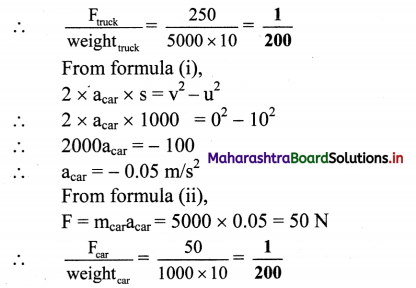
Answer:
The frictional force acting on both the truck and the car is \(\frac{1}{200}\) of their weight.

Question 2.
A lighter object A and a heavier object B are initially at rest. Both are imparted the same linear momentum. Which will start with greater kinetic energy: A or B or both will start with the same energy?
[Ans: A]
Solution:
Question 3.
As i was standing on a weighing machine inside a lift it recorded 50 kg wt. Suddenly for few seconds it recorded 45 kg wt. What must have happened during that time? Explain with complete numerical analysis. [Ans: Lift must be coming down with acceleration \(\frac{\mathrm{g}}{10}\) = 1 ms-2]
Solution:
The weight recorded by weighing machine is always apparent weight and a measure of reaction force acting on the person. As the apparent weight (45 kg-wt) in this case is less than actual weight (50 kg-wt) the lift must be accelerated downwards during that time.
Numerical Analysis
Question 4.
Figure below shows a block of mass 35 kg resting on a table. The table is so rough that it offers a self adjusting resistive force 10% of the weight of the block for its sliding motion along the table. A 20 kg wt load is attached to the block and is passed over a pulley to hang freely on the left side. On the right side there is a 2 kg wt pan attached to the block and hung freely. Weights of 1 kg wt each, can be added to the pan. Minimum how many and maximum how many such weights can be added into the pan so that the block does not slide along the table? [Ans: Min 15, maximum 21].

Solution:
Frictional (resistive) force f = 10% (weight)
= \(\frac{10}{100}\) × 35 × 10 = 35N 100
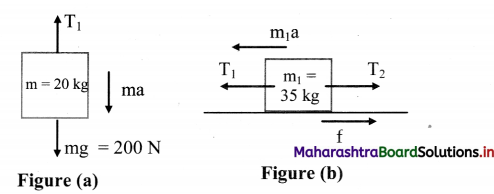
i. Consider FBD for 20 kg-wt load. Initially, the block kept on the table is moving towards left, because of the movement of block of mass 20 kg in downward direction.
Thus, for block of mass 20 kg,
ma = mg – T1 …. (1)
Consider the forces acting on the block of mass 35 kg in horizontal direction only as shown in figure (b). Thus, the force equation for this block is, m1a = T1 – T2 – f ….(2)
To prevent the block from sliding across the table,
m1a = ma = 0
∴ T1 = mg = 200 N ….[From (1)]
T1 = T2 + f ….[From (2)]
∴ T2 + f = 200
∴ T2 = 200 – 35 = 165 N
Thus, the total force acting on the block from right hand side should be 165 N.
∴ Total mass = 16.5 kg
∴ Minimum weight to be added = 16.5 – 2 = 14.5 kg
≈ 15 weights of 1 kg each
ii. Now, considering motion of the block towards right, the force equations for the masses in the pan and the block of mass 35 kg can be determined from FBD shown
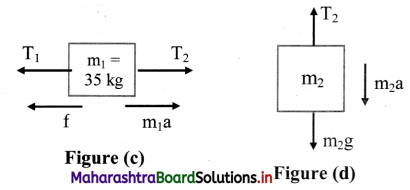
From figure (c)
m1a = T2 – T1 – f ….(iii)
From figure (d),
m2a = m2g – T2 … .(iv)
To prevent the block of mass 35 kg from sliding across the table, m1a = m2a = 0
From equations (iii) and (iv),
T2 = T1 + f
T2 = m2g
∴ m2g = 200 + 35 = 235 N
∴ The maximum mass required to stop the sliding = 23.5 – 2 = 21.5kg ≈ 21 weights of 1 kg
Answer:
The minimum 15 weights and maximum 21 weights of 1 kg each are required to stop the block from sliding.
Question 5.
Power is rate of doing work or the rate at which energy is supplied to the system. A constant force F is applied to a body
of mass m. Power delivered by the force at time t from the start is proportional to
(a) t
(b) t2
(c) \(\sqrt{t}\)
(d) t0
Derive the expression for power in terms of F, m and t.
[Ans: p = \(\frac{F^{2} t}{m}\), ∴ p ∝ t]
Solution:
Derivation for expression of power:
i. A constant force F is applied to a body of mass (m) initially at rest (u = 0).
ii. We have,
v = u + at
∴ v = 0 + at
∴ v = at …. (1)
iii. Now, power is the rate of doing work,
∴ P = \(\frac{\mathrm{d} \mathrm{W}}{\mathrm{d} \mathrm{t}}\)
∴ P = F. \(\frac{\mathrm{d} \mathrm{s}}{\mathrm{dt}}\) [∵ dW = F. ds]
iv. But \(\frac{\mathrm{d} \mathrm{s}}{\mathrm{dt}}\) = v, the instantaneous velocity of the particle.
∴ P = F.V … (2)
v. According to Newton’s second law,
F = ma … (3)
vi. Substituting equations (1) and (3) in equation (2)
P = (ma) (at)
∴ P = ma2t
∴ P = \(\frac{m^{2} a^{2}}{m}\) × t
∴ P = \(\frac{\mathrm{F}^{2}}{\mathrm{~m}} \mathrm{t}\)
vii. As F and m are constant, therefore, P ∝ t.

Question 6.
40000 litre of oil of density 0.9 g cc is pumped from an oil tanker ship into a storage tank at 10 m higher level than the ship in half an hour. What should be the power of the pump? [Ans: 2 kW]
Solution:
h = 10 m, ρ = 0.9 g/cc = 900 kg/m3, g = 10 m/s2,
V = 40000 litre = 40000 × 103 × 10-6 m3
= 40 m3
T = 30 min = 1800 s
To find: Power(P)
Formula: P = \(\frac{\mathrm{W}}{\mathrm{t}}=\frac{\mathrm{h} \rho \mathrm{gV}}{\mathrm{t}}\)
Calculation: From formula,
P = \(\frac{10 \times 900 \times 10 \times 40}{1800}\)
∴ P = 2000 W
∴ P = 2 kW
Answer:
The power of the pump is 2 kW.
Question 7.
Ten identical masses (m each) are connected one below the other with 10 strings. Holding the topmost string, the system is accelerated upwards with acceleration g/2. What is the tension in the 6th string from the top (Topmost string being the first string)? [Ans: 6 mg]
Solution
Consider the 6th string from the top. The number of masses below the 6th string is 5. Thus, FBD for the 6th mass is given in figure (b).
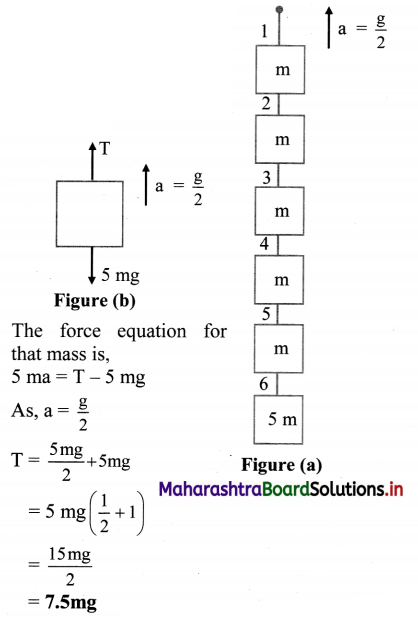
Answer:
Tension in the 6th string is 7.5 mg.
[Note: The answer given above is modified considering the correct textual concepts.]
Question 8.
Two galaxies of masses 9 billion solar mass and 4 billion solar mass are 5 million light years apart. If, the Sun has to cross the line joining them, without being attracted by either of them, through what point it should pass? [Ans: 3 million light years from the 9 billion solar mass]
Solution:
The Sun can cross the line joining the two galaxies without being attracted by either of them if it passes from a neutral point. Neutral point is a point on the line joining two objects where effect of gravitational forces acting due to both the objects is nullified.
Given that;
m1 = 9 × 109 Ms
m2 = 4 × 109 Ms
r = 5 × 106 light years
Let the neutral point be at distance x from mi. If sun is present at that point,
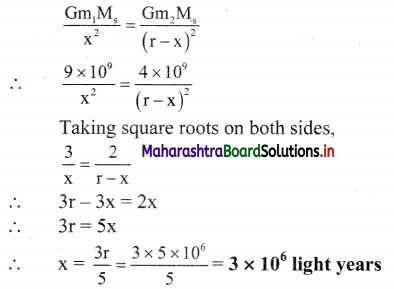
Answer: The Sun has to cross the line from a point at a distance 3 million light years from the galaxy of mass 9 billion solar mass.
Question 9.
While decreasing linearly from 5 N to 3 N, a force displaces an object from 3 m to 5 m. Calculate the work done by this force during this displacement. [Ans: 8 N]
Solution:
For a variable force, work done is given by area under the curve of force v/s displacement graph. From given data, graph can be plotted as follows:
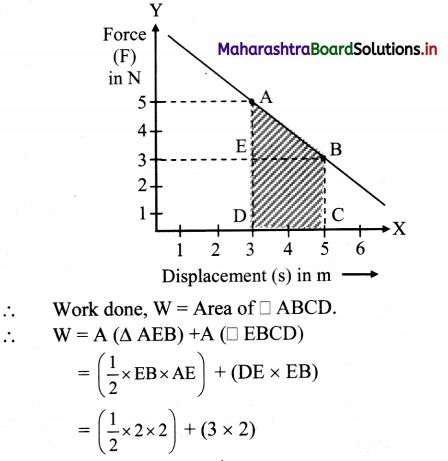
= 8 J
Ans: Work done is 8 J.
[Note: According to the definition of work done, S.J. unit of wõrk done is joule (J)]
Alternate solution:
Work done, w = Area of trapezium ADCB
∴ W = \(\frac{1}{2}\)(AD + CB) × DC
∴ W = 1 (5N + 3N) × (5m – 3m)
= \(\frac{1}{2}\) × 8 × 2 = 8J

Question 10.
Variation of a force in a certain region is given by F = 6x2 – 4x – 8. It displaces an object from x = 1 m to x = 2 m in this region. Calculate the amount of work
done. [Ans: Zero]
Solution:
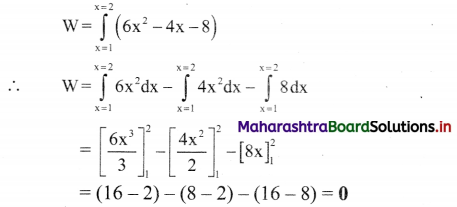
Answer:
The work done is zero.
Question 11.
A ball of mass 100 g dropped on the ground from 5 m bounces repeatedly. During every bounce 64% of the potential energy is converted into kinetic energy. Calculate the following:
(a) Coefficient of restitution.
(b) Speed with which the ball comes up from the ground after third bounce.
(c) Impulse given by the ball to the ground during this bounce.
(d) Average force exerted by the ground if this impact lasts for 250 ms.
(e) Average pressure exerted by the ball on the ground during this impact if contact area of the ball is 0.5 cm2.
[Ans: 0.8, 5.12 m/s, 1.152N s, 4.608 N, 9.216 × 104 N/m2]
Solution:
Given that, for every bounce, the 64% of initial energy is converted to final energy.
i. Coefficient of restitution in case of inelastic collision is given by,
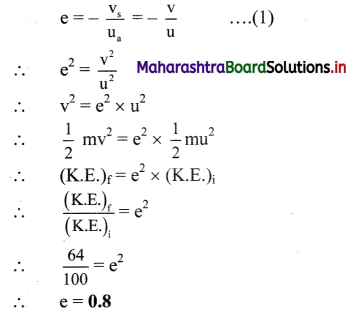
ii. From equation (1),
∴ v = – eu
∴ After first bounce,
v1 = – eu
after second bounce,
v2 = -ev1 = -e(-eu)= e2u
and after third bounce,
v3 = – ev2 = – e(e2u) = – e3u
But u = \(\sqrt{2 \mathrm{gh}}\)

iii. Impulse given by the ball during third bounce, is,
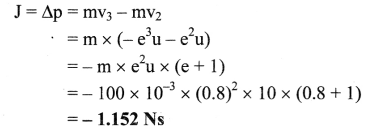
iv. Average force exerted in 250 ms,
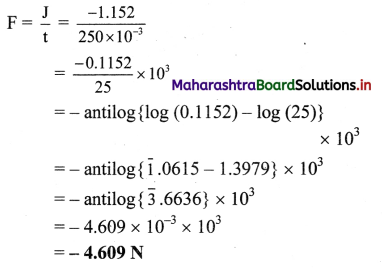
v. Average pressure for area
0.5 cm2 = 0.5 × 10-4m2
P = \(\frac{\mathrm{F}}{\mathrm{A}}=\frac{4.608}{0.5 \times 10^{-4}}\) = 9.216 × 104 N/m2
Question 12.
A spring ball of mass 0.5 kg is dropped from some height. On falling freely for 10 s, it explodes into two fragments of
mass ratio 1:2. The lighter fragment continues to travel downwards with speed of 60 m/s. Calculate the kinetic energy supplied during explosion. [Ans: 200 J]
Solution:
m1 + m2 = 0.5 kg, m1 : m2 = 1 : 2,
m1 = \(\frac{1}{6}\) kg,
∴ m2 = \(\frac{1}{3}\) kg
Initially, when the ball is falling freely for 10s,
v = u + at = 0 + 10(10)
∴ v = 100 m/s = u1 = u2
(m1 + m2)v = m1v1 + m2v2
∴ 0.5 × 100 = \(\frac{1}{6}\)(60) + \(\frac{1}{3}\)v2
∴ 50 = 10 + \(\frac{1}{3}\)v2
∴ 40 = \(\frac{1}{3}\)v2
∴ v2 = 120m/s
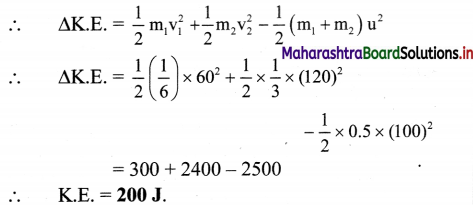
∴ K.E. = 200J.
Ans: Kinetic energy supplied is 200 J.
Question 13.
A marble of mass 2m travelling at 6 cm/s is directly followed by another marble of mass m with double speed. After collision, the heavier one travels with the average initial speed of the two. Calculate the coefficient of restitution. [Ans: 0.5]
Solution:
Given: m1 = 2m, m2 = m, u1 = 6 cm/s,
u2 = 2u1 = 12 cm/s,
v1 = \(\frac{\mathrm{u}_{1}+\mathrm{u}_{2}}{2}\) = 9cm/s
To find: Coefficient of restitution(e)
Formulae:
i. m1u1 +m2u2 = m1v1 + m2v2
ii. e = \(\frac{v_{2}-v_{1}}{u_{1}-u_{2}}\)
Calculation: From formula (i),
[(2m) × 6] + (m × 12) = (2m × 9) + mv2
∴ v2 = 6cm/s
From formula (ii),
e = \(\frac{6-9}{6-12}\) = \(\frac{-3}{-6}\) = 0.5
Answer: The coefficient of restitution is 0.5

Question 14.
A 2 m long wooden plank of mass 20 kg is pivoted (supported from below) at 0.5 m from either end. A person of mass 40 kg starts walking from one of these pivots to the farther end. How far can the person walk before the plank topples? [Ans: 1.25 m]
Solution:
Let the person starts walking from pivot P2 as shown in the figure.
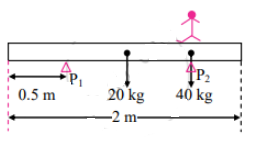
Assume the person can walk up to distance x from P1 before the plank topples. The plank will topple when the moment exerted by the person about P1 is not balanced by a moment of force due to plank about P2.
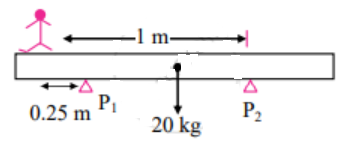
∴ For equilibrium,
40 × x = 20 × 0.5
∴ x = \(\frac{1}{4}\) = 0.25 m
Hence, the total distance walked by the person is 1.25 m.
Question 15.
A 2 m long ladder of mass 10 kg is kept against a wall such that its base is 1.2 m away from the wall. The wall is smooth but the ground is rough. Roughness of the ground is such that it offers a maximum horizontal resistive force (for sliding motion) half that of normal reaction at the point of contact. A monkey of mass 20 kg starts climbing the ladder. How far can it climb along the ladder? How much is the horizontal reaction at the wall? [Ans: 1.5 m, 15 N]
Solution:
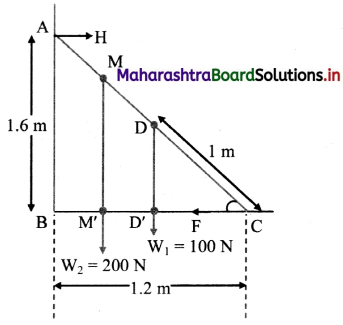
From the figure,
Given that, AC = length of ladder = 2 m
BC= 1.2m
From Pythagoras theorem,
AB = \(\sqrt{\mathrm{AC}^{2}-\mathrm{BC}^{2}}\) = 1.6 m … (i)
Also, ∆ABC ~ ∆DD’C
∴ \(\frac{\mathrm{AB}}{\mathrm{DD}^{\prime}}\) = \(\frac{\mathrm{BC}}{\mathrm{D}^{\prime} \mathrm{C}}\) = \(\frac{\mathrm{AC}}{\mathrm{DC}}\)
∴ \(\frac{1.2}{\mathrm{D}^{\prime} \mathrm{C}}=\frac{2}{1}\)
∴ D’C = 0.6 m … (ii)
The ladder exerts horizontal force \(\overrightarrow{\mathrm{H}}\) on the wall at A and \(\overrightarrow{\mathrm{F}}\) is the force exerted on the ground at C.
As |\(\overrightarrow{\mathrm{F}}\)| = \(|\overrightarrow{\mathrm{H}}|=|\overrightarrow{\mathrm{F}}|=\frac{\mathrm{N}}{2}\) … (iii)
Let monkey climb upto distance x along BC (Horizontal) i.e., CM’ = x .. . .(iv)
Then, the net normal reaction at point C will be, N = 100 + 200 = 300N
From equation (iii),
H = \(\frac{\mathrm{N}}{2}=\frac{300}{2}\) = 150N
By condition of equilibrium, taking moments about C,
(-H × AB) + (W1 × CD’) + (W2 × CM’) + (F × 0)’0
∴ (-150 × 1.6) + (100 × 0.6) + (200 × x) = 0
∴ 60 + 200x = 240
∴ 200x = 180
∴ x = 0.9
From figure, it can be shown that,
∆ABC ~ ∆MM’C
∴ \(\frac{\mathrm{BC}}{\mathrm{CM}^{\prime}}\) = \(\frac{\mathrm{AC}}{\mathrm{CM}^{\prime}}\) ∴ \(\frac{\mathrm{1.2}}{\mathrm{0.9}^{\prime}}\) = \(\frac{\mathrm{2}}{\mathrm{CM}^{\prime}}\)
∴ CM = 1.5 m
Answer:
Question 16.
Four uniform solid cubes of edges 10 cm, 20 cm, 30 cm and 40 cm are kept on the ground, touching each other in order. Locate centre of mass of their system. [Ans: 65 cm, 17.7 cm]
Solution:
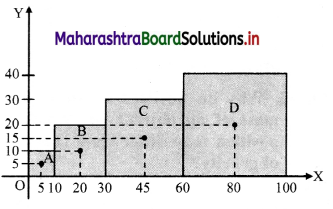
The given cubes are arranged as shown in figure. Let one of the comers of smallest cube lie at the origin.
As the cubes are uniform, let their centre of masses lie at their respective centres.
rA \(\equiv\) (5, 5), rB \(\equiv\) (20, 10), rC \(\equiv\) = (45, 15) and rD \(\equiv\) – (80, 20)
Also, masses of the cubes are,
mA = \(l_{\mathrm{A}}^{3} \times \rho=10^{3} \rho\)
mB = (20)3ρ
mC = (30)3ρ
mD = (40)3ρ
As the cubes are uniform, p is same for all of them.
∴ For X – co-ordinate of centre of mass of the system,
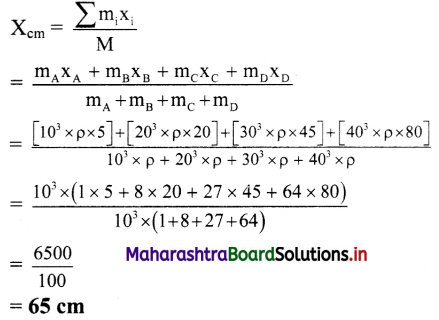
Similarly,
Y – co-ordinate of centre of mass of system is,
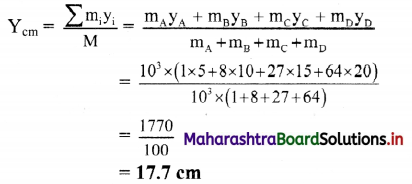
Answer: Centre of mass of the system is located at point (65 cm, 17.7 cm)

Question 17.
A uniform solid sphere of radius R has a hole of radius R/2 drilled inside it. One end of the hole is at the centre of the
sphere while the other is at the boundary. Locate centre of mass of the remaining sphere. [Ans: -R/14 ]
Solution:
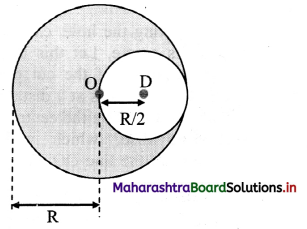
Let the centre of the sphere be origin O. Then, r1 be the position vector of centre of mass of uniform solid sphere and r2 be the position vector of centre of mass of the cut-out part of the sphere.
Now, mass of the sphere is given as,
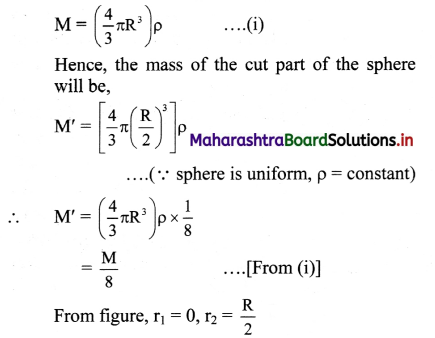
∴ Position vector of centre of mass of remaining part,
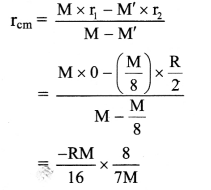
rCM = \(\frac{-\mathbf{R}}{14}\)
(Negative sign indicates the distance is on left side of the origin.)
Ans: Position of centre of mass of remaining sphere \(\frac{-\mathbf{R}}{14}\)
Question 18.
In the following table, every item on the left side can match with any number of items on the right hand side. Select all those.
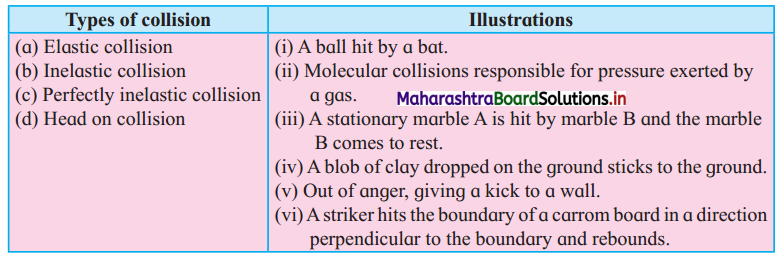
Answer:
i. Elastic collision: (b)
ii. Inelastic collision: (a), (c), (f), (e)
iii. Perfectly inelastic collision: (d)
iv. Head on collision: (c), (f)
11th Physics Digest Chapter 4 Laws of Motion Intext Questions and Answers
Can you recall? (Textbook Page No. 47)
Question 1.
What are different types of motions?
Answer:
The various types of motion are linear, uniform linear, non-uniform linear, oscillatory, circular, periodic and random motion.
Question 2.
What do you mean by kinematical equations and what are they?
Answer:
A set of three equations which analyses rectilinear motion of uniformly accelerated body and helps to predict the position of body are called as kinematical equations.
Can you tell? (Textbook Page No. 48)
Question 1.
Was Aristotle correct? If correct, explain his statement with an illustration.
Answer:
Aristotle was not correct in stating that an external force is required to keep a body in uniform motion.
Question 2.
If wrong, give the correct modified version of his statement.
Answer:
For an uninterrupted motion of a body, an additional external force is required for overcoming opposing/resistive forces.

Can you tell? (Textbook Page No. 48)
Question 1.
What is then special about Newton’s first law if it is derivable from Newton’s second law?
Answer:
Chapter 4 Laws of Motion Textbook Exercise Questions and Answers.
1. Choose the correct answer.
Question 1.
Consider following pair of forces of equal magnitude and opposite directions:
(P) Gravitational forces exerted on each other by two point masses separated by a distance.
(Q) Couple of forces used to rotate a water tap.
(R) Gravitational force and normal force experienced by an object kept on a table.
For which of these pair/pairs the two forces do NOT cancel each other’s translational
effect?
(A) Only P
(B) Only P and Q
(C) Only R
(D) Only Q and R
Answer:
(A) Only P
Question 2.
Consider following forces: (w) Force due to tension along a string, (x) Normal force given by a surface, (y) Force due to air resistance and (z) Buoyant force or upthrust given by a fluid.
Which of these are electromagnetic forces?
(A) Only w, y and z
(B) Only w, x and y
(C) Only x, y and z
(D) All four.
Answer:
(D) All four.

Question 3.
At a given instant three point masses m, 2m and 3m are equidistant from each other. Consider only the gravitational forces between them. Select correct statement/s for this instance only:
(A) Mass m experiences maximum force.
(B) Mass 2m experiences maximum force.
(C) Mass 3m experiences maximum force.
(D) All masses experience force of same magnitude.
Answer:
(C) Mass 3m experiences maximum force.
Question 4.
The rough surface of a horizontal table offers a definite maximum opposing force to initiate the motion of a block along the table, which is proportional to the resultant normal force given by the table. Forces F1 and F2 act at the same angle θ with the horizontal and both are just initiating the sliding motion of the block along the table. Force F1 is a pulling force while the force F2 is a pushing force. F2 > F1, because
(A) Component of F2 adds up to weight to increase the normal reaction.
(B) Component of F1 adds up to weight to increase the normal reaction.
(C) Component of F2 adds up to the opposing force.
(D) Component of F1 adds up to the opposing force.
Answer:
(A) Component of F2 adds up to weight to increase the normal reaction.
Question 5.
A mass 2m moving with some speed is directly approaching another mass m moving with double speed. After some time, they collide with coefficient of restitution 0.5. Ratio of their respective speeds after collision is
(A) 2/3
(B) 3/2
(C) 2
(D) ½
Answer:
(B) 3/2
Question 6.
A uniform rod of mass 2m is held horizontal by two sturdy, practically inextensible vertical strings tied at its ends. A boy of mass 3m hangs himself at one third length of the rod. Ratio of the tension in the string close to the boy to that in the other string is
(A) 2
(B) 1.5
(C) 4/3
(D) 5/3
Answer:
(B) 1.5
Question 7.
Select WRONG statement about centre of mass:
(A) Centre of mass of a ‘C’ shaped uniform rod can never be a point on that rod.
(B) If the line of action of a force passes through the centre of mass, the moment of that force is zero.
(C) Centre of mass of our Earth is not at its geometrical centre.
(D) While balancing an object on a pivot, the line of action of the gravitational force of the earth passes through the centre of mass of the object.
Answer:
(D) While balancing an object on a pivot, the line of action of the gravitational force of the earth passes through the centre of mass of the object.
Question 8.
For which of the following objects will the centre of mass NOT be at their geometrical centre?
(I) An egg
(II) a cylindrical box full of rice
(III) a cubical box containing assorted sweets
(A) Only (I)
(B) Only (I) and (II)
(C) Only (III)
(D) All, (I), (II) and (III).
Answer:
(D) All, (I), (II) and (III).
2. Answer the following questions.
Question 1.
In the following table, every entry on the left column can match with any number of entries on the right side. Pick up all those and write respectively against A, B, C and D.

Answer:

Question 2.
In real life objects, never travel with uniform velocity, even on a horizontal surface, unless something is done? Why
is it so? What is to be done?
Answer:
Question 3.
For the study of any kind of motion, we never use Newton’s first law of motion directly. Why should it be studied?
Answer:
Question 4.
Are there any situations in which we cannot apply Newton’s laws of motion? Is there any alternative for it?
Answer:
Question 5.
You are inside a closed capsule from where you are not able to see anything about the outside world. Suddenly you feel that you are pushed towards your right. Can you explain the possible cause (s)? Is it a feeling or a reality? Give at least one more situation like this.
Answer:
Question 6.
Among the four fundamental forces, only one force governs your daily life almost entirely. Justify the statement by stating that force.
Answer:
Thus, out of the four fundamental forces, electromagnetic force governs our daily life almost entirely.
Question 7.
Find the odd man out:
(i) Force responsible for a string to become taut on stretching
(ii) Weight of an object
(iii) The force due to which we can hold an object in hand.
Answer:
Weight of an object.
Reason: Weight of an object (force due to gravity) is a non-contact force while force responsible for a string to become taut (tension force) and force due to which we can hold an object in hand (normal force) are contact forces.

Question 8.
You are sitting next to your friend on ground. Is there any gravitational force of attraction between you two? If so, why are you not coming together naturally? Is any force other than the gravitational force of the earth coming in picture?
Answer:
In Chapter 5, you will study about force of gravitation in detail.
Question 9.
Distinguish between:
(A) Real and pseudo forces,
(B) Conservative and non-conservative forces,
(C) Contact and non-contact forces,
(D) Inertial and non-inertial frames of reference.
Answer:
(A) Real and pseudo forces,
| No | Real force | Pseudo Force |
| i. | A force which is produced due to interaction between the objects is called real force. | A pseudo force is one which arises due to the acceleration of the observer’s frame of reference. |
| ii. | Real forces obey Newton’s laws of motion. | Pseudo forces do not obey Newton’s laws of motion. |
| iii. | Real forces are one of the four fundamental forces. | Pseudo forces are not among any of the four fundamental forces. |
| Example: The earth revolves around the sun in circular path due to gravitational force of attraction between the sun and the earth. | Example: Bus is moving with an acceleration (a) on a straight road in forward direction, a person of mass ‘m’ experiences a backward pseudo force of magnitude ‘ma’. |
| No | Conservative | Non-conservative forces |
| i. | If work done by or against a force is independent’ of the actual path, the force is said to be a conservative force. | If work done by or against a force is dependent of the actual path, the force is said to be a non- conservative force. |
| ii. | During work done by a conservative force, the mechanical energy is conserved. | During work done by a non conservative force, the mechanical energy may not be conserved. |
| iii. | Work done is completely recoverable. | Work done is not recoverable. |
| Example: gravitational force, magnetic force etc. |
Example: Frictional force, air drag etc. |
| No | Contact forces | Non-contact forces |
| i. | The forces experienced by a body due to physical contact are called contact forces. | The forces experienced by a body without any physical contact are called non-contact forces. |
| ii. | Example: gravitational force, electrostatic force, magnetostatic force etc. | Example: Frictional force, force exerted due to collision, normal reaction etc. |
| No. | Inertial frame of reference | Non-inertial frame of reference |
| i | The body moves with a constant velocity (can be zero). | The body moves with variable velocity. |
| ii. | Newton’s laws are | Newton’s laws are |
| iii. | The body does not accelerate. | The body undergoes acceleration. |
| iv. | In this frame, force acting on a body is a real force. | The acceleration of the frame gives rise to a pseudo force. |
| Example: A rocket in inter-galactic space (gravity free space between galaxies) with all its engine shut. | Example: If a car just starts its motion from rest, then during the time of acceleration the car will be in a non- inertial frame of reference. |
State the formula for calculating work done by a force. Are there any conditions or limitations in using it directly? If so, state those clearly. Is there any mathematical way out for it? Explain.
Answer:
Conditions/limitations for application of work formula:
Integral method to find work done by a variable force:

Question 11.
Justify the statement, “Work and energy are the two sides of a coin”.
Answer:
Thus, work and energy are the two sides of the same

Question 12.
From the terrace of a building of height H, you dropped a ball of mass m. It reached the ground with speed v. Is the relation mgH = \(\frac{1}{2} m \mathrm{v}^{2}\) applicable exactly? If not, how can you account for the difference? Will the ball bounce to the same height from where it was dropped?
Answer:
Question 13.
State the law of conservation of linear momentum. It is a consequence of which law? Given an example from our daily life for conservation of momentum. Does it hold good during burst of a cracker?
Answer:
Question 14.
Define coefficient of restitution and obtain its value for an elastic collision and a perfectly inelastic collision.
Answer:
i. For two colliding bodies, the negative of ratio of relative velocity of separation to relative velocity of approach is called the coefficient of restitution.
ii. Consider an head-on collision of two bodies of masses m1 and m2 with respective initial velocities u1 and u2. As the collision is head on, the colliding masses are along the same line before and after the collision. Relative velocity of approach is given as,
ua = u2 – u1
Let v1 and v2 be their respective velocities after the collision. The relative velocity of recede (or separation) is then vs = v2 – v1

iii. For a head on elastic collision, According to the principle of conservation of linear momentum,
Total initial momentum = Total final momentum

iv. For a perfectly inelastic collision, the colliding bodies move jointly after the collision, i.e., v1 = v2
∴ v1 – v2 = 0
Substituting this in equation (1), e = 0.

Question 15.
Discuss the following as special cases of elastic collisions and obtain their exact or approximate final velocities in terms
of their initial velocities.
(i) Colliding bodies are identical.
(ii) A very heavy object collides on a lighter object, initially at rest.
(iii) A very light object collides on a comparatively much massive object, initially at rest.
Answer:
The final velocities after a head-on elastic collision is given as,

i. Colliding bodies are identical
If m1 = m2, then v1 = u2 and v2 = u1
Thus, objects will exchange their velocities after head on elastic collision.
ii. A very heavy object collides with a lighter object, initially at rest.
Let m1 be the mass of the heavier body and m2 be the mass of the lighter body i.e., m1 >> m2; lighter particle is at rest i.e., u2 = 0 then,

i.e., the heavier colliding body is left unaffected and the lighter body which is struck, travels with double the speed of the massive striking body.
iii. A very light object collides on a comparatively much massive object, initially at rest.
If m1 is mass of a light body and m2 is mass of heavy body i.e., m1 << m2 and u2 = 0. Thus, m1 can be neglected.
Hence v1 ≅ -u1, and v2 ≅ 0.
i.e., the tiny (lighter) object rebounds with same speed while the massive object is unaffected.
Question 16.
A bullet of mass m1 travelling with a velocity u strikes a stationary wooden block of mass m2 and gets embedded into it. Determine the expression for loss in the kinetic energy of the system. Is this violating the principle of conservation of energy? If not, how can you account for this loss?
Answer:
Loss in the kinetic energy during a perfectly inelastic head on collision:
Question 17.
One of the effects of a force is to change the momentum. Define the quantity related to this and explain it for a variable
force. Usually when do we define it instead of using the force?
Answer:
Need to define impulse:
Impulse for a variable force:

In chapter 3, you have studied the concept of using area under the curve.

Question 18.
While rotating an object or while opening a door or a water tap we apply a force or forces. Under which conditions is this process easy for us? Why? Define the vector quantity concerned. How does it differ for a single force and for two opposite forces with different lines of action?
Answer:
| No. | Moment of a force | Moment of a couple |
| i. | Moment of a force is given as, \(\vec{\tau}=\vec{r} \times \vec{F}\) | Moment of a couple is given as, \(\vec{\tau}=\vec{r}_{12} \times \vec{F}_{1}=\vec{r}_{21} \times \vec{F}_{2}\) |
| ii. | It depends upon the axis of rotation and the point of application of the force. | It depends only upon the two forces, i.e., it is independent of the axis of rotation or the points of application of forces. |
| iii. | It can produce translational acceleration also, if the axis of rotation is not fixed or if friction is not enough. | Does not produce any translational acceleration, but produces only rotational or angular acceleration. |
| iv. | Its rotational effect can be balanced by a proper single force or by a proper couple. | Its rotational effect can be balanced only by another couple of equal and opposite torque. |
Why is the moment of a couple independent of the axis of rotation even if the axis is fixed?
Answer:
Question 20.
Explain balancing or mechanical equilibrium. Linear velocity of a rotating fan as a whole is generally zero. Is it in
mechanical equilibrium? Justify your answer.
Answer:
Question 21.
Why do we need to know the centre of mass of an object? For which objects, its position may differ from that of the centre of gravity?
Use g = 10 m s-2, unless, otherwise stated.
Answer:
3. Solve the following problems.
Question 1.
A truck of mass 5 ton is travelling on a horizontal road with 36 km hr-1 stops on travelling 1 km after its engine fails suddenly. What fraction of its weight is the frictional force exerted by the road? If we assume that the story repeats for a car of mass 1 ton i.e., can moving with same speed stops in similar distance same how much will the fraction be?
[Ans: \(\frac{1}{200}\) in the both]
Solution:
Given: mtruck = 5 ton = 5000 kg,
mcar = 1 ton = 1000 kg,
u = 36km/hr = 10 m/s,
v = 0 m/s, s = 1 km = 1000 m
To find: Ratio of force of friction to the weight of vehicle
Formulae:
i. v2 = u2 + 2as
ii. F = ma
Calculation: From formula (i),
2 × atruck × s = v2 – u2
∴ 2 × atruck × 1000 = 02 – 102
∴ 200atruck = -100
∴ atruck = -0.05 m/s2
Negative sign indicates that velocity is decreasing
From formula (ii),
Ftruck = mtruck × atruck = 5000 × 0.05
= 250 N

Answer:
The frictional force acting on both the truck and the car is \(\frac{1}{200}\) of their weight.

Question 2.
A lighter object A and a heavier object B are initially at rest. Both are imparted the same linear momentum. Which will start with greater kinetic energy: A or B or both will start with the same energy?
[Ans: A]
Solution:
Question 3.
As i was standing on a weighing machine inside a lift it recorded 50 kg wt. Suddenly for few seconds it recorded 45 kg wt. What must have happened during that time? Explain with complete numerical analysis. [Ans: Lift must be coming down with acceleration \(\frac{\mathrm{g}}{10}\) = 1 ms-2]
Solution:
The weight recorded by weighing machine is always apparent weight and a measure of reaction force acting on the person. As the apparent weight (45 kg-wt) in this case is less than actual weight (50 kg-wt) the lift must be accelerated downwards during that time.
Numerical Analysis
Question 4.
Figure below shows a block of mass 35 kg resting on a table. The table is so rough that it offers a self adjusting resistive force 10% of the weight of the block for its sliding motion along the table. A 20 kg wt load is attached to the block and is passed over a pulley to hang freely on the left side. On the right side there is a 2 kg wt pan attached to the block and hung freely. Weights of 1 kg wt each, can be added to the pan. Minimum how many and maximum how many such weights can be added into the pan so that the block does not slide along the table? [Ans: Min 15, maximum 21].

Solution:
Frictional (resistive) force f = 10% (weight)
= \(\frac{10}{100}\) × 35 × 10 = 35N 100

i. Consider FBD for 20 kg-wt load. Initially, the block kept on the table is moving towards left, because of the movement of block of mass 20 kg in downward direction.
Thus, for block of mass 20 kg,
ma = mg – T1 …. (1)
Consider the forces acting on the block of mass 35 kg in horizontal direction only as shown in figure (b). Thus, the force equation for this block is, m1a = T1 – T2 – f ….(2)
To prevent the block from sliding across the table,
m1a = ma = 0
∴ T1 = mg = 200 N ….[From (1)]
T1 = T2 + f ….[From (2)]
∴ T2 + f = 200
∴ T2 = 200 – 35 = 165 N
Thus, the total force acting on the block from right hand side should be 165 N.
∴ Total mass = 16.5 kg
∴ Minimum weight to be added = 16.5 – 2 = 14.5 kg
≈ 15 weights of 1 kg each
ii. Now, considering motion of the block towards right, the force equations for the masses in the pan and the block of mass 35 kg can be determined from FBD shown

From figure (c)
m1a = T2 – T1 – f ….(iii)
From figure (d),
m2a = m2g – T2 … .(iv)
To prevent the block of mass 35 kg from sliding across the table, m1a = m2a = 0
From equations (iii) and (iv),
T2 = T1 + f
T2 = m2g
∴ m2g = 200 + 35 = 235 N
∴ The maximum mass required to stop the sliding = 23.5 – 2 = 21.5kg ≈ 21 weights of 1 kg
Answer:
The minimum 15 weights and maximum 21 weights of 1 kg each are required to stop the block from sliding.
Question 5.
Power is rate of doing work or the rate at which energy is supplied to the system. A constant force F is applied to a body
of mass m. Power delivered by the force at time t from the start is proportional to
(a) t
(b) t2
(c) \(\sqrt{t}\)
(d) t0
Derive the expression for power in terms of F, m and t.
[Ans: p = \(\frac{F^{2} t}{m}\), ∴ p ∝ t]
Solution:
Derivation for expression of power:
i. A constant force F is applied to a body of mass (m) initially at rest (u = 0).
ii. We have,
v = u + at
∴ v = 0 + at
∴ v = at …. (1)
iii. Now, power is the rate of doing work,
∴ P = \(\frac{\mathrm{d} \mathrm{W}}{\mathrm{d} \mathrm{t}}\)
∴ P = F. \(\frac{\mathrm{d} \mathrm{s}}{\mathrm{dt}}\) [∵ dW = F. ds]
iv. But \(\frac{\mathrm{d} \mathrm{s}}{\mathrm{dt}}\) = v, the instantaneous velocity of the particle.
∴ P = F.V … (2)
v. According to Newton’s second law,
F = ma … (3)
vi. Substituting equations (1) and (3) in equation (2)
P = (ma) (at)
∴ P = ma2t
∴ P = \(\frac{m^{2} a^{2}}{m}\) × t
∴ P = \(\frac{\mathrm{F}^{2}}{\mathrm{~m}} \mathrm{t}\)
vii. As F and m are constant, therefore, P ∝ t.

Question 6.
40000 litre of oil of density 0.9 g cc is pumped from an oil tanker ship into a storage tank at 10 m higher level than the ship in half an hour. What should be the power of the pump? [Ans: 2 kW]
Solution:
h = 10 m, ρ = 0.9 g/cc = 900 kg/m3, g = 10 m/s2,
V = 40000 litre = 40000 × 103 × 10-6 m3
= 40 m3
T = 30 min = 1800 s
To find: Power(P)
Formula: P = \(\frac{\mathrm{W}}{\mathrm{t}}=\frac{\mathrm{h} \rho \mathrm{gV}}{\mathrm{t}}\)
Calculation: From formula,
P = \(\frac{10 \times 900 \times 10 \times 40}{1800}\)
∴ P = 2000 W
∴ P = 2 kW
Answer:
The power of the pump is 2 kW.
Question 7.
Ten identical masses (m each) are connected one below the other with 10 strings. Holding the topmost string, the system is accelerated upwards with acceleration g/2. What is the tension in the 6th string from the top (Topmost string being the first string)? [Ans: 6 mg]
Solution
Consider the 6th string from the top. The number of masses below the 6th string is 5. Thus, FBD for the 6th mass is given in figure (b).

Answer:
Tension in the 6th string is 7.5 mg.
[Note: The answer given above is modified considering the correct textual concepts.]
Question 8.
Two galaxies of masses 9 billion solar mass and 4 billion solar mass are 5 million light years apart. If, the Sun has to cross the line joining them, without being attracted by either of them, through what point it should pass? [Ans: 3 million light years from the 9 billion solar mass]
Solution:
The Sun can cross the line joining the two galaxies without being attracted by either of them if it passes from a neutral point. Neutral point is a point on the line joining two objects where effect of gravitational forces acting due to both the objects is nullified.
Given that;
m1 = 9 × 109 Ms
m2 = 4 × 109 Ms
r = 5 × 106 light years
Let the neutral point be at distance x from mi. If sun is present at that point,

Answer: The Sun has to cross the line from a point at a distance 3 million light years from the galaxy of mass 9 billion solar mass.
Question 9.
While decreasing linearly from 5 N to 3 N, a force displaces an object from 3 m to 5 m. Calculate the work done by this force during this displacement. [Ans: 8 N]
Solution:
For a variable force, work done is given by area under the curve of force v/s displacement graph. From given data, graph can be plotted as follows:

= 8 J
Ans: Work done is 8 J.
[Note: According to the definition of work done, S.J. unit of wõrk done is joule (J)]
Alternate solution:
Work done, w = Area of trapezium ADCB
∴ W = \(\frac{1}{2}\)(AD + CB) × DC
∴ W = 1 (5N + 3N) × (5m – 3m)
= \(\frac{1}{2}\) × 8 × 2 = 8J

Question 10.
Variation of a force in a certain region is given by F = 6x2 – 4x – 8. It displaces an object from x = 1 m to x = 2 m in this region. Calculate the amount of work
done. [Ans: Zero]
Solution:

Answer:
The work done is zero.
Question 11.
A ball of mass 100 g dropped on the ground from 5 m bounces repeatedly. During every bounce 64% of the potential energy is converted into kinetic energy. Calculate the following:
(a) Coefficient of restitution.
(b) Speed with which the ball comes up from the ground after third bounce.
(c) Impulse given by the ball to the ground during this bounce.
(d) Average force exerted by the ground if this impact lasts for 250 ms.
(e) Average pressure exerted by the ball on the ground during this impact if contact area of the ball is 0.5 cm2.
[Ans: 0.8, 5.12 m/s, 1.152N s, 4.608 N, 9.216 × 104 N/m2]
Solution:
Given that, for every bounce, the 64% of initial energy is converted to final energy.
i. Coefficient of restitution in case of inelastic collision is given by,

ii. From equation (1),
∴ v = – eu
∴ After first bounce,
v1 = – eu
after second bounce,
v2 = -ev1 = -e(-eu)= e2u
and after third bounce,
v3 = – ev2 = – e(e2u) = – e3u
But u = \(\sqrt{2 \mathrm{gh}}\)

iii. Impulse given by the ball during third bounce, is,

iv. Average force exerted in 250 ms,

v. Average pressure for area
0.5 cm2 = 0.5 × 10-4m2
P = \(\frac{\mathrm{F}}{\mathrm{A}}=\frac{4.608}{0.5 \times 10^{-4}}\) = 9.216 × 104 N/m2
Question 12.
A spring ball of mass 0.5 kg is dropped from some height. On falling freely for 10 s, it explodes into two fragments of
mass ratio 1:2. The lighter fragment continues to travel downwards with speed of 60 m/s. Calculate the kinetic energy supplied during explosion. [Ans: 200 J]
Solution:
m1 + m2 = 0.5 kg, m1 : m2 = 1 : 2,
m1 = \(\frac{1}{6}\) kg,
∴ m2 = \(\frac{1}{3}\) kg
Initially, when the ball is falling freely for 10s,
v = u + at = 0 + 10(10)
∴ v = 100 m/s = u1 = u2
(m1 + m2)v = m1v1 + m2v2
∴ 0.5 × 100 = \(\frac{1}{6}\)(60) + \(\frac{1}{3}\)v2
∴ 50 = 10 + \(\frac{1}{3}\)v2
∴ 40 = \(\frac{1}{3}\)v2
∴ v2 = 120m/s

∴ K.E. = 200J.
Ans: Kinetic energy supplied is 200 J.
Question 13.
A marble of mass 2m travelling at 6 cm/s is directly followed by another marble of mass m with double speed. After collision, the heavier one travels with the average initial speed of the two. Calculate the coefficient of restitution. [Ans: 0.5]
Solution:
Given: m1 = 2m, m2 = m, u1 = 6 cm/s,
u2 = 2u1 = 12 cm/s,
v1 = \(\frac{\mathrm{u}_{1}+\mathrm{u}_{2}}{2}\) = 9cm/s
To find: Coefficient of restitution(e)
Formulae:
i. m1u1 +m2u2 = m1v1 + m2v2
ii. e = \(\frac{v_{2}-v_{1}}{u_{1}-u_{2}}\)
Calculation: From formula (i),
[(2m) × 6] + (m × 12) = (2m × 9) + mv2
∴ v2 = 6cm/s
From formula (ii),
e = \(\frac{6-9}{6-12}\) = \(\frac{-3}{-6}\) = 0.5
Answer: The coefficient of restitution is 0.5

Question 14.
A 2 m long wooden plank of mass 20 kg is pivoted (supported from below) at 0.5 m from either end. A person of mass 40 kg starts walking from one of these pivots to the farther end. How far can the person walk before the plank topples? [Ans: 1.25 m]
Solution:
Let the person starts walking from pivot P2 as shown in the figure.

Assume the person can walk up to distance x from P1 before the plank topples. The plank will topple when the moment exerted by the person about P1 is not balanced by a moment of force due to plank about P2.

∴ For equilibrium,
40 × x = 20 × 0.5
∴ x = \(\frac{1}{4}\) = 0.25 m
Hence, the total distance walked by the person is 1.25 m.
Question 15.
A 2 m long ladder of mass 10 kg is kept against a wall such that its base is 1.2 m away from the wall. The wall is smooth but the ground is rough. Roughness of the ground is such that it offers a maximum horizontal resistive force (for sliding motion) half that of normal reaction at the point of contact. A monkey of mass 20 kg starts climbing the ladder. How far can it climb along the ladder? How much is the horizontal reaction at the wall? [Ans: 1.5 m, 15 N]
Solution:

From the figure,
Given that, AC = length of ladder = 2 m
BC= 1.2m
From Pythagoras theorem,
AB = \(\sqrt{\mathrm{AC}^{2}-\mathrm{BC}^{2}}\) = 1.6 m … (i)
Also, ∆ABC ~ ∆DD’C
∴ \(\frac{\mathrm{AB}}{\mathrm{DD}^{\prime}}\) = \(\frac{\mathrm{BC}}{\mathrm{D}^{\prime} \mathrm{C}}\) = \(\frac{\mathrm{AC}}{\mathrm{DC}}\)
∴ \(\frac{1.2}{\mathrm{D}^{\prime} \mathrm{C}}=\frac{2}{1}\)
∴ D’C = 0.6 m … (ii)
The ladder exerts horizontal force \(\overrightarrow{\mathrm{H}}\) on the wall at A and \(\overrightarrow{\mathrm{F}}\) is the force exerted on the ground at C.
As |\(\overrightarrow{\mathrm{F}}\)| = \(|\overrightarrow{\mathrm{H}}|=|\overrightarrow{\mathrm{F}}|=\frac{\mathrm{N}}{2}\) … (iii)
Let monkey climb upto distance x along BC (Horizontal) i.e., CM’ = x .. . .(iv)
Then, the net normal reaction at point C will be, N = 100 + 200 = 300N
From equation (iii),
H = \(\frac{\mathrm{N}}{2}=\frac{300}{2}\) = 150N
By condition of equilibrium, taking moments about C,
(-H × AB) + (W1 × CD’) + (W2 × CM’) + (F × 0)’0
∴ (-150 × 1.6) + (100 × 0.6) + (200 × x) = 0
∴ 60 + 200x = 240
∴ 200x = 180
∴ x = 0.9
From figure, it can be shown that,
∆ABC ~ ∆MM’C
∴ \(\frac{\mathrm{BC}}{\mathrm{CM}^{\prime}}\) = \(\frac{\mathrm{AC}}{\mathrm{CM}^{\prime}}\) ∴ \(\frac{\mathrm{1.2}}{\mathrm{0.9}^{\prime}}\) = \(\frac{\mathrm{2}}{\mathrm{CM}^{\prime}}\)
∴ CM = 1.5 m
Answer:
Question 16.
Four uniform solid cubes of edges 10 cm, 20 cm, 30 cm and 40 cm are kept on the ground, touching each other in order. Locate centre of mass of their system. [Ans: 65 cm, 17.7 cm]
Solution:

The given cubes are arranged as shown in figure. Let one of the comers of smallest cube lie at the origin.
As the cubes are uniform, let their centre of masses lie at their respective centres.
rA \(\equiv\) (5, 5), rB \(\equiv\) (20, 10), rC \(\equiv\) = (45, 15) and rD \(\equiv\) – (80, 20)
Also, masses of the cubes are,
mA = \(l_{\mathrm{A}}^{3} \times \rho=10^{3} \rho\)
mB = (20)3ρ
mC = (30)3ρ
mD = (40)3ρ
As the cubes are uniform, p is same for all of them.
∴ For X – co-ordinate of centre of mass of the system,

Similarly,
Y – co-ordinate of centre of mass of system is,

Answer: Centre of mass of the system is located at point (65 cm, 17.7 cm)

Question 17.
A uniform solid sphere of radius R has a hole of radius R/2 drilled inside it. One end of the hole is at the centre of the
sphere while the other is at the boundary. Locate centre of mass of the remaining sphere. [Ans: -R/14 ]
Solution:

Let the centre of the sphere be origin O. Then, r1 be the position vector of centre of mass of uniform solid sphere and r2 be the position vector of centre of mass of the cut-out part of the sphere.
Now, mass of the sphere is given as,

∴ Position vector of centre of mass of remaining part,

rCM = \(\frac{-\mathbf{R}}{14}\)
(Negative sign indicates the distance is on left side of the origin.)
Ans: Position of centre of mass of remaining sphere \(\frac{-\mathbf{R}}{14}\)
Question 18.
In the following table, every item on the left side can match with any number of items on the right hand side. Select all those.

Answer:
i. Elastic collision: (b)
ii. Inelastic collision: (a), (c), (f), (e)
iii. Perfectly inelastic collision: (d)
iv. Head on collision: (c), (f)
11th Physics Digest Chapter 4 Laws of Motion Intext Questions and Answers
Can you recall? (Textbook Page No. 47)
Question 1.
What are different types of motions?
Answer:
The various types of motion are linear, uniform linear, non-uniform linear, oscillatory, circular, periodic and random motion.
Question 2.
What do you mean by kinematical equations and what are they?
Answer:
A set of three equations which analyses rectilinear motion of uniformly accelerated body and helps to predict the position of body are called as kinematical equations.
Can you tell? (Textbook Page No. 48)
Question 1.
Was Aristotle correct? If correct, explain his statement with an illustration.
Answer:
Aristotle was not correct in stating that an external force is required to keep a body in uniform motion.
Question 2.
If wrong, give the correct modified version of his statement.
Answer:
For an uninterrupted motion of a body, an additional external force is required for overcoming opposing/resistive forces.

Can you tell? (Textbook Page No. 48)
Question 1.
What is then special about Newton’s first law if it is derivable from Newton’s second law?
Answer: